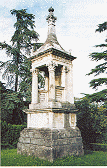Sarsina
has very ancient origins, since it has been built by the humbrian
population between the VI and the IV century b.C. 
In the III century b.C. Sarsina already governed a big country, which
included some Romagna valleys and the highest part of the river Tevere.
The economy of the territory was based on the resources coming from the
exploitation of the forests and of the countries ( wool, hides, cheeses,
wood).
The first certain date of the history of Sarsina is that of its conquest
by the romans, in the 266 b.C. After that, Sarsina became a federate town
and then a Municipality.
In the 250 b.C. Sarsina was the birthplace of Tito Maccio Plauto, the
greatest latin playwright, who left 21 plays, which nowadays are still
performed with big success.
Sarsina saw a real economical rise and an urban development in the first
half of the 1st
century b.C. when , after the social war, all federate cities of Rome
where given the roman citizenship.
The city walls and some of the great mausoleums, which were built by noble
families, date back to the late republican age.
The town became then a big emporio, where people from the East established
their sanctuaries, managing to escape for a long time the agricoltural
crisis of the Pianura Padana.
Between the end of the III and the beginning of the IV century Sarsina had
S. Vicinio as its first bishop and then as its Saint Patron. His fame as
thaumaturge and exorcist is still great.
 Declined after the collapse of the roman empire, Sarsina suffered
from devastations and sacks and, in spite of being submitted to different
dominations ( Ordelaffi,Malatesta, Veneziani), it managed to preserve a part of its own
importance thanks to the fact that it was the bishop’s seat.
Declined after the collapse of the roman empire, Sarsina suffered
from devastations and sacks and, in spite of being submitted to different
dominations ( Ordelaffi,Malatesta, Veneziani), it managed to preserve a part of its own
importance thanks to the fact that it was the bishop’s seat.
Untill 1859, Sarsina belonged to the Stato Pontificio ( the state belonging to the Pope)
and then to the new Italian Reign.
In 1944, Sarsina underwent a cruel nazist reprisal, where a lot of people were killed or
wounded, by the fire of several private houses and public buildings.
The economy, which was before exclusively an agricoltural one, changed a lot in the
Sixtieth’s through the installing of several factories, which provided a flourishing
craftmanship.
Nowadays, Sarsina is a very important turistic center with great prospects for the future,
thanks to its big Archeological Museum, its Cathedral where it is
possible to receive the "S.Vicinio’s blessing" ( that attracts thousands of
pilgrims every year), its environmental beauties and thanks to its easy connection with
the E45 highway.
|
![]()